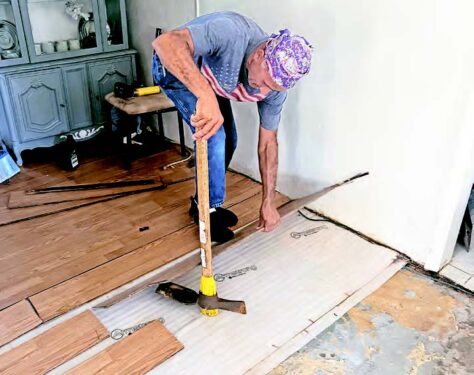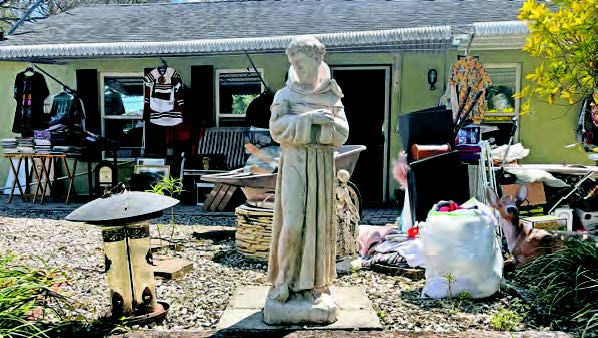
FORT MYERS, Fla. — Looking around at fallen tree limbs and brush littered throughout her yard, Elizabeth Reyes couldn’t help but notice that the usual natural sounds of birds overhead were gone, replaced by the sounds of machinery used for power and clean-up after Hurricane Ian.
“What’s overwhelming for me is the humming of generators and chainsaws because you know the trees are being cut down, and that gave us shade and shelter,” Reyes told The Tablet. “And now, instead of the humming of the birds, it’s the humming of generators and chainsaws.”
The situation inside Reyes’ home is worse. The structure withstood the storm, but it flooded and now she and her husband, Luis, have to replace the floors and a good portion of the drywall throughout.
About a block away, the Brewster family home on the Caloosahatchee River suffered a similar fate. The structure survived, but the family also has to replace the home’s floors and drywall after an estimated three-and-a-half feet of flood water got inside.

Outside, the Brewster’s koi fish pond and above ground swimming pool are gone. A large damaged sailboat — that isn’t theirs — sits horizontal in the middle of their backyard. “It’s definitely going to be a very, very long project,” Annabel Brewster told The Tablet.
To further complicate the recovery process for the Reyes and Brewster families, neither has flood or home insurance to cover any of the damage — an unfortunate reality that many Floridians affected by Hurricane Ian face. As a result they have to rely on compensation they get from the Federal Emergency Management Agency (FEMA), private organizations/donors, and their own savings to rebuild.
Regular homeowners’ insurance policies typically don’t cover flood damage, which is why FEMA offers flood insurance through its National Flood Insurance Program (NFIP). The coverage, though, has average premiums close to $1,000, making it unaffordable for lower income residents.
“There’s no way we can afford flood insurance and I don’t know if anyone around here has flood insurance and we’re a block away from the [Caloosahatchee River],” Reyes said. “You can’t afford it. You’re living paycheck to paycheck and whatever else we have we use.”
Brewster noted that another factor in her family not having flood insurance is historical precedent. She said their home was built by her grandparents in the 1950s, and until Hurricane Ian, has never incurred any damage or flooded because of a hurricane.
Both factors — the cost and perceived lack of need — are reasons that a low percentage of residents in the areas hardest hit by Hurricane Ian have flood insurance.
Only 18.5% of homes in the counties where residents were told to evacuate had federally-issued flood insurance, according to Milliman, a consulting firm that works with NFIP. Some 47.3% of homes in those counties inside the government-designated floodplain had flood insurance. Meanwhile, in the areas outside of the high-risk flood zones, only 9.4% had a federal flood insurance policy, Milliman found.
FEMA announced on Oct. 7 that it had already given more than $90 million in federal disaster assistance to Hurricane Ian survivors to help with temporary housing, home repairs, and other uninsured or underinsured disaster-related losses.
The Initial Clean-Up Continues
Two weeks have passed since Hurricane Ian made landfall in southwest Florida, and while families like the Reyeses and Brewsters have begun considering how to approach the long-term fixes required to get back into their homes, they’re still largely focused on the initial clean-up of their properties.
The Reyes family has hung clothes outside and laid irreplaceable family mementos, photos, and other items that were unharmed from the storm on tables outside, with still a few more rooms to sift through. Inside, Luis Reyes has already used a pick ax to tear up much of the wood flooring.
The Reyeses have lived in the home for 23 years and have no intention of leaving, no matter the damage or the difficulty of the rebuild. Luis said the reason is simple: “This is home.”
“This is my house. This is my heritage,” he told The Tablet. “The day that I die, the wife will keep on it, and the day that my wife dies, there is a will there. That, for me, is important. The land symbolizes your roots. It symbolizes where you came from.”
When The Tablet visited the home on Oct. 5, Luis was in high spirits even as he ripped up floorboards and assessed how much was lost in the yard. Asked about his mindset, he said he doesn’t have a choice but to keep going.
“We were brought up that God only gives you so little, and at the same time, there’s nothing you can do,” Reyes said. “You either sit down and cry, or you move and do something for yourself because, in the end, pity is not going to get anything solved.”
That same day Catholic Charities of Venice brought a couple of Mennonite builders to the house to assess the damage, with intentions to help fund and construct the rebuild of the Reyes family’s home.
The Brewsters are doing much of the same: clearing out everything inside their home and washing the floors to prevent mold before they rip them up. They’ve applied for FEMA relief to hopefully cover the costs of the rebuild and, like the Reyeses, have not considered moving elsewhere.
“We have so many family ties here,” Brewster said. “There’s so many family memories that we have here that we can’t just move somewhere else because it’s not the same.”

